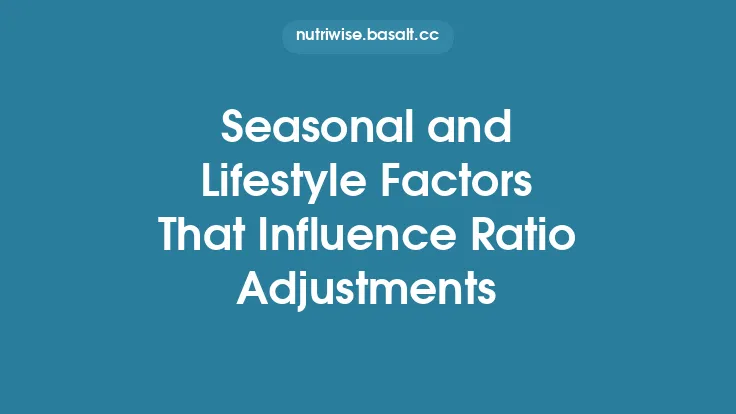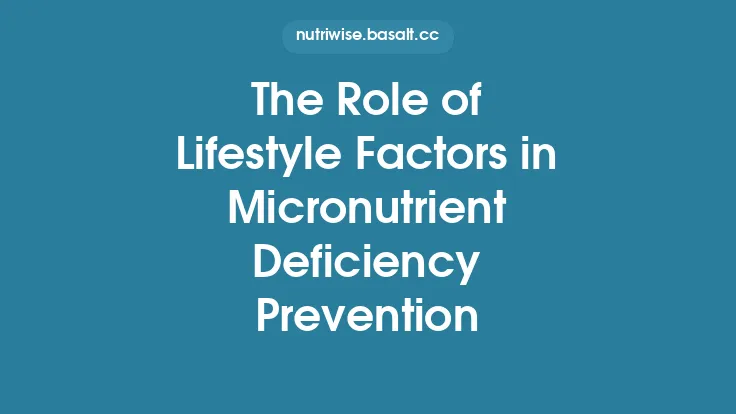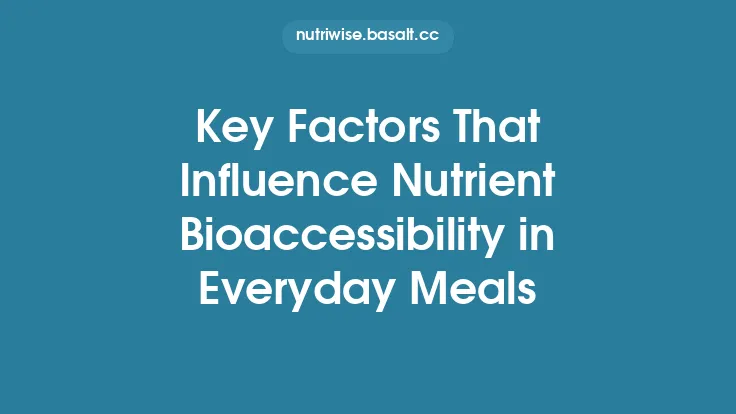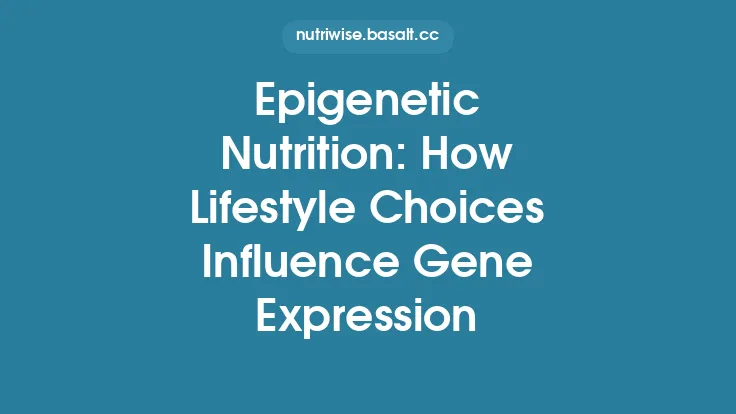Iron metabolism is a finely tuned physiological process that goes far beyond the simple act of swallowing a bite of food. While the chemical steps of iron absorption and transport are well‑documented, the day‑to‑day choices we make—how we move, rest, cope with stress, and even the environments we inhabit—can profoundly shape the efficiency of iron handling in the body. Understanding these lifestyle influences is essential for anyone looking to maintain optimal iron status and reduce the risk of anemia, especially because many of the factors are modifiable and can be integrated into everyday routines without the need for medical intervention.
Physical Activity and Iron Turnover
Exercise‑Induced Hemolysis and Iron Loss
Intense or prolonged physical activity, particularly endurance sports such as marathon running or long‑distance cycling, can cause mechanical hemolysis— the rupture of red blood cells (RBCs) as they pass through capillaries under high shear stress. This process releases hemoglobin into the plasma, which is subsequently cleared by macrophages. While the body recycles a substantial portion of the liberated iron, a fraction is lost through sweat, urine, and gastrointestinal bleeding associated with high‑intensity training.
Training Adaptations and Hepcidin Dynamics
Hepcidin, the master regulator peptide produced by the liver, controls iron egress from enterocytes, macrophages, and hepatocytes by binding to the iron exporter ferroportin and triggering its internalization. Acute bouts of exercise raise circulating hepcidin levels for up to 24 hours, a response mediated by interleukin‑6 (IL‑6) released from contracting muscles. This transient hepcidin surge temporarily reduces dietary iron absorption and iron release from stores, which can be problematic if training sessions are frequent and dietary iron intake is marginal.
Conversely, regular moderate‑intensity exercise (e.g., brisk walking, light jogging) tends to lower baseline hepcidin concentrations over weeks, likely through improved anti‑inflammatory status and enhanced erythropoietic signaling. Athletes who periodize their training—alternating high‑intensity phases with recovery weeks—allow hepcidin levels to normalize, supporting more consistent iron absorption.
Practical Recommendations
- Schedule iron‑rich meals (or fortified foods) at least 4 hours after intense workouts when hepcidin is expected to be elevated.
- Incorporate recovery days to permit hepcidin normalization.
- Monitor hemolysis markers (e.g., plasma free hemoglobin, haptoglobin) in high‑performance athletes to detect excessive RBC loss early.
Sleep Quality and Hormonal Regulation of Iron
The Sleep‑Hepcidin Connection
Sleep deprivation triggers a cascade of hormonal alterations, notably increased cortisol and catecholamines, which promote systemic inflammation. Elevated inflammatory cytokines (IL‑6, tumor necrosis factor‑α) stimulate hepatic hepcidin synthesis, thereby reducing iron export from storage sites. Chronic short sleep (< 6 hours/night) has been linked in epidemiological studies to higher ferritin concentrations—a marker of iron sequestration—yet paradoxically lower circulating transferrin saturation, reflecting functional iron deficiency.
Growth Hormone, Erythropoiesis, and Nighttime Recovery
Growth hormone (GH) peaks during deep (slow‑wave) sleep and exerts a stimulatory effect on erythropoietin (EPO) production. Adequate GH secretion supports robust erythropoiesis, which in turn drives iron utilization. Disrupted sleep architecture blunts GH surges, potentially dampening the erythropoietic drive and contributing to suboptimal iron turnover.
Practical Recommendations
- Aim for 7–9 hours of consolidated sleep per night to maintain low basal hepcidin.
- Prioritize sleep hygiene (dark, cool bedroom; limited screen exposure) to preserve slow‑wave sleep and GH release.
- Consider timing of iron‑rich meals earlier in the day, as nocturnal hepcidin peaks may be attenuated after a full night of restorative sleep.
Stress and Inflammatory Pathways Affecting Iron Homeostasis
Chronic Psychosocial Stress as a Driver of Functional Iron Deficiency
Persistent psychological stress activates the hypothalamic‑pituitary‑adrenal (HPA) axis, leading to sustained cortisol elevation. Cortisol, together with stress‑induced cytokines (IL‑1β, IL‑6), upregulates hepcidin transcription via the STAT3 signaling pathway. The resulting “iron‑trapping” phenotype mirrors the anemia of chronic disease, where iron is abundant in storage cells but unavailable for erythropoiesis.
Mind‑Body Interventions
Mindfulness‑based stress reduction (MBSR), yoga, and regular aerobic activity have been shown to lower circulating IL‑6 and cortisol levels. By attenuating the inflammatory milieu, these practices indirectly reduce hepcidin expression, facilitating more efficient iron mobilization.
Practical Recommendations
- Integrate daily stress‑management techniques (e.g., 10‑minute meditation, deep‑breathing exercises).
- Schedule regular physical activity that you enjoy, as it serves both stress‑reduction and iron‑regulatory functions.
- Monitor inflammatory markers (CRP, IL‑6) if you suspect chronic stress is impacting iron status.
Alcohol Consumption and Its Dual Impact on Iron Metabolism
Acute Alcohol Intake: Transient Iron Absorption Boost
Ethanol can increase intestinal permeability and stimulate the expression of divalent metal transporter‑1 (DMT1) in enterocytes, leading to a short‑term rise in non‑heme iron absorption. This effect is most pronounced after moderate, acute consumption (e.g., a single glass of wine with a meal).
Chronic Alcohol Use: Hepatic Iron Overload and Dysregulation
Long‑term heavy drinking induces hepatic inflammation and steatosis, which elevate hepcidin production and impair ferroportin function. Paradoxically, chronic alcoholics often develop iron overload in the liver while simultaneously experiencing functional iron deficiency in the peripheral circulation, predisposing them to anemia of chronic disease.
Practical Recommendations
- Limit alcohol to moderate levels (≤ 1 drink/day for women, ≤ 2 drinks/day for men) to avoid chronic dysregulation.
- Avoid binge drinking, especially around meals where iron absorption is a priority.
- Screen for liver function (ALT, AST, ferritin) in individuals with regular alcohol intake.
Smoking, Carbon Monoxide, and Iron Utilization
Carbon Monoxide Binding and Hemoglobin Affinity
Cigarette smoke contains carbon monoxide (CO), which binds hemoglobin with an affinity ~200 times greater than oxygen, forming carboxyhemoglobin. This reduces the oxygen‑carrying capacity of RBCs, prompting compensatory erythropoiesis that increases iron demand.
Oxidative Stress and Iron Sequestration
Smoking generates reactive oxygen species (ROS) that trigger inflammatory pathways, raising hepcidin levels and promoting iron sequestration in macrophages. Moreover, nicotine can impair gastrointestinal motility, potentially affecting iron absorption indirectly.
Practical Recommendations
- Quit smoking to reduce CO‑induced erythropoietic stress and lower inflammatory hepcidin signaling.
- Consider nicotine replacement therapies that lack the combustion by‑products of tobacco.
- Monitor complete blood count (CBC) and ferritin in long‑term smokers, as they may develop a mixed picture of iron deficiency and functional iron restriction.
Medication and Supplement Interactions
Proton Pump Inhibitors (PPIs) and Gastric Acidity
PPIs raise gastric pH, diminishing the solubility of non‑heme iron, which is optimal in an acidic environment. Chronic PPI use can therefore blunt iron absorption, especially in individuals whose dietary iron is already marginal.
Antacids, Calcium Supplements, and Competitive Transport
Calcium competes with iron for DMT1-mediated uptake in the duodenum. High‑dose calcium supplements taken concurrently with iron‑containing meals can reduce iron absorption by up to 50 %.
Antimicrobial Agents and Gut Microbiota
Broad‑spectrum antibiotics disrupt the intestinal microbiome, potentially altering bacterial siderophore production and iron recycling. While the clinical impact is modest, repeated courses may contribute to subtle shifts in iron homeostasis.
Practical Recommendations
- Space out PPIs or antacids at least 2 hours before iron‑rich meals.
- Separate calcium supplementation from iron intake (e.g., take calcium at bedtime).
- Use antibiotics judiciously and consider probiotic support to maintain a healthy gut flora.
Gut Microbiota: An Emerging Modulator of Iron Balance
Microbial Competition for Luminal Iron
The intestinal microbiome harbors both commensal and opportunistic bacteria that vie for luminal iron. Certain beneficial strains (e.g., Lactobacillus spp.) produce bacteriocins that limit pathogenic iron‑scavenging bacteria, indirectly preserving iron for host absorption.
Siderophores and Host Signaling
Bacterial siderophores—high‑affinity iron‑chelating molecules—can influence host iron regulatory pathways. Some siderophores bind to intestinal receptors, modulating hepcidin expression via the BMP‑SMAD signaling cascade. Dysbiosis, characterized by overgrowth of siderophore‑producing pathogens, may trigger inappropriate hepcidin elevation and iron sequestration.
Dietary Fiber and Prebiotic Effects
High‑fiber diets foster short‑chain fatty acid (SCFA) production, which strengthens the intestinal barrier and reduces low‑grade inflammation. Lower inflammation translates to reduced hepcidin synthesis, facilitating iron mobilization.
Practical Recommendations
- Consume a diverse, fiber‑rich diet (whole grains, legumes, fruits, vegetables) to support a balanced microbiome.
- Include fermented foods (yogurt, kefir, sauerkraut) that deliver live cultures capable of competing for iron.
- Avoid unnecessary long‑term antibiotic courses that can disrupt microbial iron handling.
Hormonal Influences: Menstrual Cycle, Pregnancy, and Thyroid Function
Menstrual Blood Loss and Cyclical Iron Demand
Women of reproductive age experience monthly iron losses ranging from 0.5 to 2 mg per day, depending on flow intensity. The follicular phase is associated with lower hepcidin levels, facilitating iron absorption to compensate for anticipated loss, whereas the luteal phase sees a modest hepcidin rise.
Pregnancy: Expanded Plasma Volume and Fetal Transfer
During pregnancy, plasma volume expands by ~50 %, diluting circulating hemoglobin (physiologic anemia). Simultaneously, the placenta expresses high levels of ferroportin to export iron to the fetus, driven by increased maternal erythropoietin and reduced hepcidin. Failure to meet these heightened demands can precipitate iron‑deficiency anemia, affecting both mother and child.
Thyroid Hormones and Metabolic Rate
Hyperthyroidism accelerates erythropoiesis, increasing iron utilization, while hypothyroidism slows RBC production, potentially masking iron deficiency. Thyroid hormones also modulate hepcidin transcription via the STAT3 pathway, linking thyroid status to iron homeostasis.
Practical Recommendations
- Track menstrual flow and adjust dietary iron or supplementation during heavy months.
- Prioritize prenatal iron intake (dietary and, if needed, supplemental) early in pregnancy to build reserves before the third trimester surge.
- Screen thyroid function in individuals with unexplained anemia or abnormal iron studies.
Environmental and Occupational Exposures
Altitude and Hypoxia‑Driven Erythropoiesis
Living at high altitude (> 2,500 m) induces chronic hypoxia, stimulating erythropoietin production and expanding RBC mass. This heightened erythropoietic drive increases iron demand, often reflected by lower serum ferritin despite adequate intake.
Heavy Metals and Iron Interference
Exposure to lead, cadmium, or arsenic can disrupt iron metabolism. Lead competes with iron for binding sites on transport proteins (e.g., DMT1) and impairs heme synthesis enzymes, leading to functional iron deficiency. Cadmium interferes with ferroportin function, reducing iron export from enterocytes.
Practical Recommendations
- If residing at altitude, consider periodic iron status monitoring and modest dietary adjustments.
- Minimize exposure to heavy metals by using certified water filters, avoiding lead‑based paints, and following occupational safety guidelines.
- Employ chelation therapy only under medical supervision when heavy‑metal burden is confirmed.
Chronobiology: Circadian Rhythms and Iron Regulation
Diurnal Variation of Hepcidin
Hepcidin exhibits a circadian pattern, peaking in the early morning (around 6–8 a.m.) and reaching its nadir in the late afternoon. This rhythm aligns with typical feeding schedules, ensuring maximal iron absorption during daylight hours when meals are consumed.
Timing of Iron‑Containing Meals
Consuming iron‑rich foods or supplements during the hepcidin trough (mid‑afternoon to early evening) can enhance absorption efficiency. Conversely, taking iron supplements immediately upon waking may coincide with higher hepcidin levels, reducing bioavailability.
Practical Recommendations
- Schedule iron‑rich meals (or supplements) between 2 p.m. and 6 p.m. when hepcidin is naturally lower.
- Maintain consistent sleep‑wake cycles to preserve the integrity of circadian hepcidin oscillations.
- Avoid shift work when possible, as irregular light exposure can disrupt circadian regulation of iron metabolism.
Practical Lifestyle Strategies for Optimizing Iron Metabolism
- Balance Exercise Intensity – Combine moderate aerobic activity with strength training, and incorporate rest days to prevent chronic hepcidin elevation.
- Prioritize Sleep – Aim for 7–9 hours of quality sleep; align iron‑rich meals with the afternoon hepcidin nadir.
- Manage Stress – Adopt daily mindfulness or relaxation practices to keep inflammatory cytokines and cortisol in check.
- Moderate Alcohol – Keep consumption within recommended limits; avoid binge drinking around meals.
- Quit Smoking – Eliminate CO‑induced erythropoietic stress and reduce inflammation.
- Mind Medication Timing – Separate PPIs, antacids, and calcium from iron intake; discuss any long‑term antibiotic use with a healthcare provider.
- Support Gut Health – Eat a fiber‑rich, diverse diet; include fermented foods; limit unnecessary antibiotics.
- Track Hormonal Cycles – For menstruating individuals, adjust iron intake during heavy flow; for pregnant women, begin iron optimization early.
- Limit Toxic Exposures – Use protective equipment in occupational settings; test water and soil for heavy metals when relevant.
- Respect Circadian Rhythms – Keep regular sleep schedules; time iron consumption to align with natural hepcidin lows.
By weaving these evidence‑based lifestyle adjustments into daily life, individuals can create an internal environment that supports efficient iron handling, reduces the risk of functional iron deficiency, and promotes overall hematologic health. While genetics and underlying medical conditions also play roles, the modifiable factors outlined above empower anyone to take proactive steps toward optimal iron metabolism and anemia prevention.





